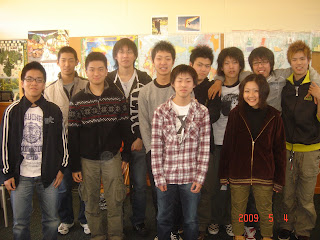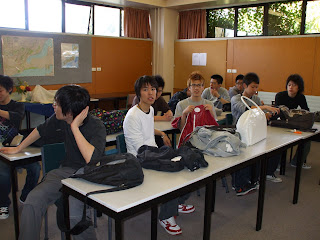These following conversations were recorded in class. I use them to illustrate how conversational styles are different between Japan and New Zealand, or between a high context culture and a low context culture.
Conversation Analysis 1
1) HS: what did you do today, Hiroko?
Really the question here is; tell me everything about what you did today - entertain me with a story. 2) S: today, today, I had a English class.
This is just a direct answer to the question, not answering the actual "behind the scenes" question. 3) HS: ask, what did you do yesterday?
4) S: yesterday? ((laughs slightly)) yesterday I had an English class. ((laughs))
5) HS: what did you do yesterday afternoon, Hiroko?
6) S: I watched, “I am Legend.” ((laughs))
7) HS: and where did you watch that?
8) S: at Hoyts.
As you can see from this conversation above, it isn't working. The student only responds to the questions in a direct manner. Compare this kind of response to the response that the teacher (T) gives further down the conversations. 1) HS: what will you do tomorrow, Masa?
2) S: tomorrow, ar, we will go to town and the library
3) HS: and the library
4) S: ((laughs slightly)) yes
5) HS: will you sleep in the library
6) S: ((laughs slightly)) no
7) HS: imm
There is no further attempt at trying to get the student to elaborate. 1) HS: What have you been doing?
2) S: arr, watch TV
3) HS: watch TV
4) S: and talking
5) HS: talking, what about your, what are they, your profiles?
6) S: arr, yes, not finished yet
T: Do you take trains in Japan?
S: Yes.
The conversation stopped here. Again, there was no elaboration. T: Is that different to here?
S: Yeah
T: I take a bicycle
S: a bicycle?
T: yeah
T: Whereabouts do the bikes ride?
S: ride? Oh, um, I’m sorry I don’t understand your question.
T: Where do the people walk? (The following is the example response I gave to the students.)
S: Near people. Oh, um, in Japan the bikes and people are on the footpath together. Actually, it’s ok for bikes to be near people because bikes go slow for people. We call these bikes “mama chari” because they go slow and many mothers ride them. They go to the supermarket to buy things on these bikes. Yeah, um, I’ve seen bikes in New Zealand are very fast – it’s different.T: Near people?
(This is the response that the student gave.)S: yeah
T: What about slang
S: slang?
T: slang, like “gidday.”
S: oh, not good
T: yeah, like not good, but it’s ok, but you know how you do grammar in Japan, we change it like slang words in English. Like cool words to say?
T: What else is different just in general?
T: what about the weather? Tell me everything about the weather in Japan.
S: oh, cold,
T: it’s spring in Japan?
S: yeah
T: Is there always snow in Japan?
S: yeah
(Again, the student didn't know how to go "behind the question" to give the response that was probably expected by the teacher, i.e., tell me everything you know about snow (or weather) in Japan.)T: I didn’t know that.
T: Do you all go skiing?
S: yeah
T: whereabouts?
(This word is usually not known by the students.)T: when you go back to Japan it’s spring again?
S: yeah
T: oh, that’s right because you’re here for a year, right?
S: yeah
T: What don’t you like to eat?
S: I don’t like pickles
(Again, there is no further explanation about pickles.)T: Pickles?
S: yeah, pickles
T: oh, right, ok
Pickles are a delicacy in Japan, but this is not commented on by the student. Yes, I know that with limited vocabulary and grammar it is difficult to explain, but I have noticed that even with proficient students, the response is not extended into anything more than just the answer given. (Next person)
S: What kind of food do you like in NZ?
(Look at how the teacher gives more information to the question than was asked. This is a good example of how the NZ teacher responds to the "behind the question's meaning." T: oh, yeah, I really like sweet food, like chocolate, yeah, I have to have
S: Tim Tams
T: yeah, I like Tim Tams, but I also like avocadoes. I like fish, but I don’t like much shellfish, usually when I go to somebody else’s house.
T: What kind of music do you have in Japan?
S: music, um oh, Jpop.
T: Jpop?
S: Japanese music
T: oh, do you like have drum and bass?
S: pardon
T: um, techno, like drum and bass?
T: Do you like Eminem?
S: yeah, of course
This seems to be a typical response by students that I have taught from Japan. There is no further elaboration. Instead, the teacher adds the following comment. Again, it is necessary to teach the students the meaning behind the question "Do you like Eminem?"T: he’s got some new songs, but he’s ok, I’m not a big fan.
T: so where else have you been to from Japan. What other countries have you been to?
S: America
T: I haven’t been to America
S: Last summer we went to study abroad
The student responds in a communicative way, but is then asked a further question by the teacher. T: oh, yeah, for how long?
S: just one month
There is no further information given, so the conversation stops. T: What do you usually like to do for fun?
S: shopping
Once again, there is just one answer given with no further comment. T: shopping?
S: yeah
T: oh, you need a lot of money for that.
The teacher provides a comment, which is not picked up by the student. The conversation then stops here. ADVICE / THINGS TO THINK ABOUT
Try to support each other, e.g. Oh, yes I agree, Oh, Imm, Yes, I think that that’s a good comment.
Laugh when everybody else laughs.
Who did all the talking in your group?
Did you speak in a Japanese/English style or an English/English style?
Explain the CEE programme. Why are you here?




